|
Main Report
The main report below contains daily accounts with the key species outlined. Click on the Weekly Systematic Lists above for a full species account.
Please be patient as the Systematic List download times are quite long. Enjoy!
Michael O'Keeffe, Author
| White-throated Cappuchin |

|
| (c) Michael O'Keeffe |
| Collared Peccary |
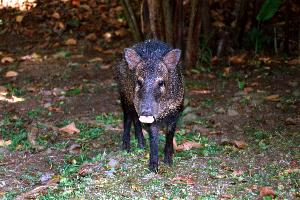
|
| (c) Michael O'Keeffe |
| Scarlet Macaw |
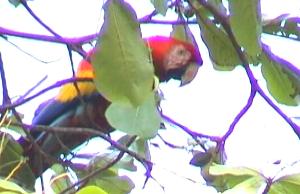
|
| (c) Michael O'Keeffe |
Introduction
Costa Rica is a well visited and well researched birding destination. The Web is full of useful information for birders visiting the country. In March 2003 Seamus Enright and I spent three weeks birding and travelling in Costa Rica. Our trip consisted of a one week organised package (with Costa Rica Gateway) followed by two weeks travelling around using a rental car (Daihatsu Terios from Adobe Car Rental). This format worked out very nicely indeed! Our trip total was 490 species with a further 15 species heard, which slightly exceeded our expectations.
In general, we found our one week package tour with Gateway to be an excellent start to the three week journey. There was only one real hiccup - at Savegre Lodge, our scheduled pickup was delayed arriving and our driver got lost making his way to the final destination of our package tour at Tarcol Lodge. While we were only mildly inconvenienced by such slip-ups we would recommend double-checking all aspects of ones itinerary to avoid disappointment. In general we would certainly recommend Costa Rica Gateway. The quality of accommodation, food, guides and birds at Rancho Naturalista, Savegre Logde and Tarcol Lodge were all first class!
Considering that neither Seamus nor myself could speak Spanish, we still got by with the minimum of fuss during the remaining two weeks.
Reference Material
Travel Guide: Rough Guide To Costa Rica (XXX)
Field Guide: A guide to the birds of Costa Rica (by Skutch), Helm (XXXX)
Site Guide: A Travel and Site Guide to Birds of Costa Rica, Lone Pine Publishing 1996 (XXXX)
Audio Guide: Voices of Costa Rican Birds, Cornell Laboratory of Ornithology (XXXX)
Map: Costa Rica Laminated Map (Berndtson and Berndtrson,1999) (XXXX) Websites and Trip-Reports: Too many to mention.
| Blue Morpho Butterfly |
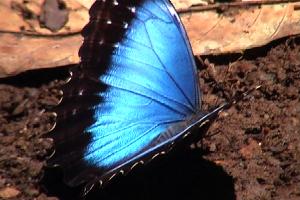
|
| (c) Michael O'Keeffe |
| Rancho Naturalista |
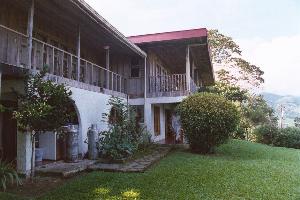
|
| (c) Michael O'Keeffe |
Day by Day Reports
Feb 28th Flight
11.00am Continental flight from Shannon, Ireland to Newark, New Jersey with a four-hour stopover, followed by an onward flight to San Jose, Costa Rica. Arrived in San Jose at 9.00pm local time. The Continental flights were reasonably good (price approx. 900 Euro per person). Our only difficulties were with the check-in bedlam at Newark airport where we needed every minute of our four-hour stopover to make our flights on time! We considered the check-in in Newark to be worse than Goa in India which is saying something! 1st night spent at Cacts Hotel in San Jose (basic but comfortable with some good birding opportunities in the morning).
Mar 1st San Jose and Rancho-Naturalista We began birding from the balcony at Cacts Hotel at dawn. This provided a good introduction to the common city birds (some of which were not seen again during the remaining three weeks). Highlights included a male Hepatic Tanager, Crimson-fronted Parakeet (common), Greyish Saltator, White-winged Dove (common) and Common Ground-Dove. Costa Rica Gateway arranged our pickup at Cacts Hotel at 9.00am. We arrived at Rancho Naturalista (RN) at around 12.00. RN provides luxury accommodation, great food, superb birding and very knowledgeable guides. We would strongly recommend spending two to three days is this area. Birding begins from the balcony where feeders provide great views of Hummingbirds, Tanagers and more. There are also morning and afternoon guided walks along excellent trails. With the help of our excellent guide Steven, best birds during the first afternoon included Taiga Merlin, White-throated Crake, Black-crested Coquette, Garden Emerald, Snowcap, Purple-crowned fairy, Tawny-throated Leaftosser, Black-headed Nightingale Thrush and White-crowned Manakin.
| Montezuma Oropendola |
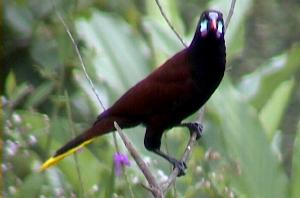
|
| (c) Michael O'Keeffe |
| Snowcap |
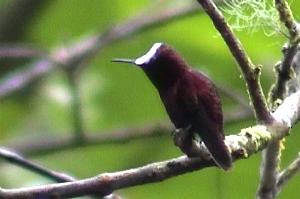
|
| (c) Michael O'Keeffe |
| Hoffman's Woodpecker |
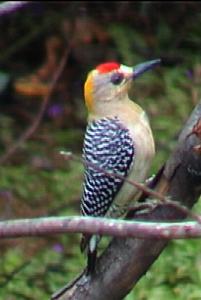
|
| (c) Michael O'Keeffe |
Mar 2nd Rancho Naturalista (Cerro Silencio) We were very fortunate that our superb guide Fredrick had decided to make a rare trek to Cerro Silencio. This superb area offers species not likely to be found elsewhere and without doubt this was one of the most rewarding excursions during the whole three weeks. The days tally produced such star birds as Black Guan, Barred Hawk, Sulphur-winged Parakeet (common), Vaux's Swift, Green-fronted Lancebill, Black-bellied Hummingbird, both White-bellied and Purple throated mountain-gems, Green-crowned brilliant, both Red-headed and Prong-billed Barbets (quite common), Strong-billed Woodcreeper, Brown-billed Scythbill, Red-faced Spinetail, Lovely Cotinga (at a well known site), Golden-bellied Flycatcher, Scale-crested pygmy-tyrant, Rufous-browed Tyrannulat, Dark Pewee, Olive-striped Flycatcher, Rufous-browed Peppershrike, both Olive-crowned and Grey-crowned Yellowthroats, Golden-browed Chlorophonia, Blue-hooded Euphonia, Highland Hepatic Tanager and Yellow-throated Brushfinch. Seamus also had a brief view of a Tamandua (a species of anteater).
| Lovely Cotinga |
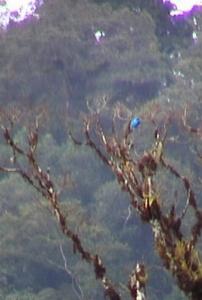
|
| (c) Michael O'Keeffe |
| Strong-billed Woodcreeper |

|
| (c) Michael O'Keeffe |
Mar 3rd Rancho Naturalista Trails We spent a full day in and around the trails at RN. Highlights included Crested Guan, Lineated Woodpecker, Plain-brown Woodcreeper, Buff-throated foliage gleaner, Russet Antshrike, both Immaculate and Spotted Antbirds, Checker-throated Antwren (heard only), Tawny-chested Flycatcher (a RN speciality) and Striped-breasted Wren. We were also treated to stunning views of a pair of Tayra. As we walked a trail not far from the lodge, these large, powerful muscellids dropped vertically forty feet of more out of a tree - a truly memorable sight!
| Violaceous Trogon |
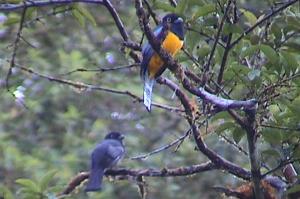
|
| (c) Michael O'Keeffe |
| Tawny-chested Flycatcher |
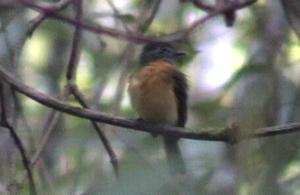
|
| (c) Michael O'Keeffe |
| Green Thorntail |
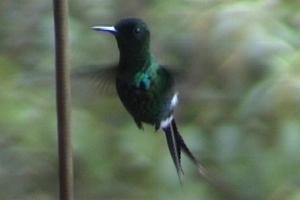
|
| (c) Michael O'Keeffe |
Mar 4th Rancho Naturalista, Savegre Lodge After breakfast we spent a few hours on the trails before departing for Savegre Lodge near Cerro de la Muerte. At RN we had views of Plain Antvireo, Mottled Owl (at a day roost) and Slaty Spinetail (nest site), Black-crowned Tityra, Yellow-olive Flycatcher and Black-headed Tody-flycatcher. After a 3.5 hour journey we reached the entrance road to Savegre where we were fortunate to locate Timberline Wren. The afternoon until dusk, spent around the lower elevation trails at Savegre, produced such species as Red-tailed Hawk, Dusky Nightjar, Steel-vented, Scintillant and Volcano Hummingbirds, Green Violetear, Respendant Quetzal (stunning views of a male at its nest), Black Phoebe, Torrent Tyrannulet and Slaty-flowerpiercer. At Savegre Lodge we were accompanied at various different stages by the two excellent guides Mario and Melvin. The accommodation and food at Savegre Logde are of a high standard however Savegre did not match the homely, secluded feel of RN.
| Scintillant Hummingbird |
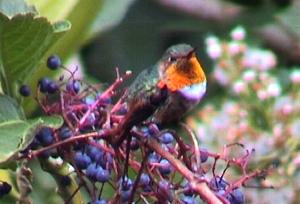
|
| (c) Michael O'Keeffe |
| Resplendant Quetzal |
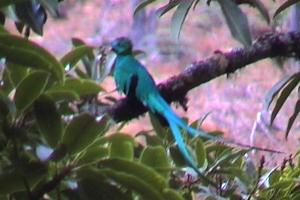
|
| (c) Michael O'Keeffe |
| Collared Trogon |
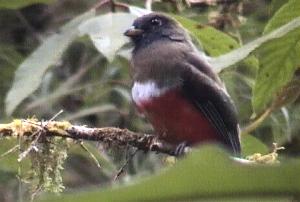
|
| (c) Michael O'Keeffe |
Mar 5th Savegre Lodge and Cerro de la Muerte At dawn, we ticked Yellow-bellied Siskin roosting in the trees in front of the restaurant. We than set out birding along the mid and higher elevation trails with our excellent guide, Melvin. Good birds included Band-tailed pigeon, Hairy Woodpecker, Ruddy Treerunner (common), Barred Beckard, Ochraceous Pewee, Black-capped flycatcher, Yellowish Flycatcher, Mountain Elaenia, Black-billed and Ruddy-capped Nightingale-thrushes, American Dipper, Yellow-winged and Brown-capped Vireos, Flame-throated Warbler, Sooty-backed Bush-tanagers (common), Zeledonia (tape lured) and Peg-billed Finch. We were delayed for over an hour waiting for our scheduled pickup but this was made up for with views of Fiery-throated Hummingbird and both Long-tailed silky flycatcher (common) and Black and yellow silky flycatcher (uncommon) where the entrance road to Savegre meets the highway. We then made a short visit to the top of Cerro de la Muerte for Volcano Junco (common). We arrived quite late at Tarcol Lodge owing to the schedule mix-up however food was quickly prepared for us and the inconvenience was quickly forgotten amidst tales of good birding had and more to come.
| Slaty Flowerpiercer |
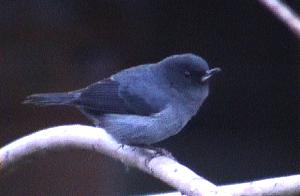
|
| (c) Michael O'Keeffe |
| Volcano Junco |
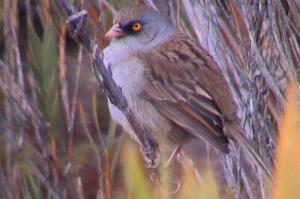
|
| (c) Michael O'Keeffe |
| Black-billed Nightingale-thrush |
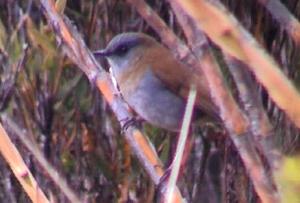
|
| (c) Michael O'Keeffe |
Mar 6th Tarcol Lodge and Carara National Park Situated along the banks of the Tarcoles River, this lodge has a rustic feel. Our birding guide Kevin Easley has a complete knowledge of the birds of the surrounding area. The first day spent at Carara National Park produced the highest day total of the entire trip at 135 species. Highlights included Reddish Egret, Elegant Tern, Crane Hawk, Ferruginous pygmy-owl, Bairds Trogon, Rufous-tailed Jacamar, White-whiskered Puffbird, Fiery-billed Aracari, Pale-billed Woodpecker, Cocoa Woodcreeper (common), Black-hooded Antshrike (common), Black-faced Antthrush, Dot-winged Antwren (common), Red-capped, Blue-crowned, Long-tailed and Orange-collared Manakins as well as Thrushlike Schiffornis, Royal Flycatcher, Slate-headed Tody Flycatcher, Northern Bentbill, Rufous-and-White Wren, Yellow-crowned, Yellow-throated and Scrub Euphonias. This was probably the best day of the three weeks.
| Rufous-tailed Jacamar |
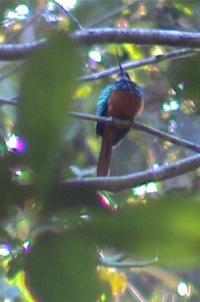
|
| (c) Michael O'Keeffe |
| Black-faced Antthrush |
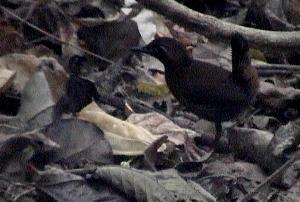
|
| (c) Michael O'Keeffe |
Mar 7th Tarcoles Lodge and surrounding sites We birded a number of sites, taking in a range of habitats including mangrove, scrub and farmland from low elevation to mid-elevation. It was a rewarding day with a number of birding highlights including King Vulture, Bare-throated tiger heron, Plumbeous Kite, White Hawk, Short-tailed Hawk, Blue ground-dove, good views of Scarlet Macaw, Orange-fronted Parakeet, White-fronted Parrot, Pacific Screech Owl (at a day roost), Chestnut-collared Swift, Band-rumped Swift, Long-tailed Hermit, Olivaceous Piculet, both Panama and Brown-crested Flycatchers, Yellow Tyrannulet, Greenish Elaenia, Grey-breasted Martin, White-throated Magpie-jay, Mangrove Vireo, Scrub Greenlet, Western Tanager, Blue Grosbeak, Painted Bunting, Blue-black Grosbeak, Blue-black Grassquit and Strip-headed Sparrow. The animal highlight of the day was the sighting of a small green Snake eating a huge frog!
| Pacific Screech-owl |
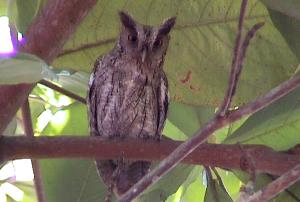
|
| (c) Michael O'Keeffe |
| King Vulture |
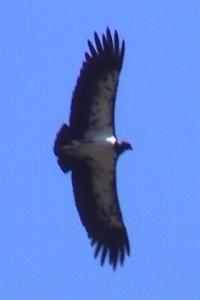
|
| (c) Michael O'Keeffe |
Mar 8th Tarcoles River, San Jose and Monteverde As we were due to pick up our rental vehicle back in San Jose at 1.00pm, we decided to take a leisurely boat trip in the mangroves near the mouth of the Tarcoles River as our final excursion at Tarcol Lodge. This provided a number of surprises including Boat-billed Heron (common along some stretches), Collared Plover (at the river mouth debris belt only), Scaly-breasted and Mangrove Hummingbirds and Scrub Flycatcher. On the return trip to San Jose we stopped briefly at the square in Orotina for the very reliable Black and White Owls. Here we also saw Two-toed Sloth. Finally, having picked up our Dihatsu Terios rental car, we made the long journey to Monteverde before dark. Along the winding road up to Monteverde, a party of Spot-bellied Bobwhite crossed in front of us - a surprise and welcome find. We found plenty of choice in accommodation and restaurants in Santa Elena.
| Tarcoles River birding from Tarcol Lodge |
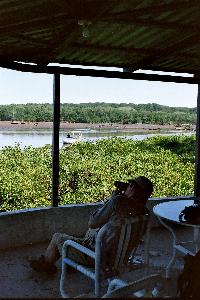
|
| (c) Michael O'Keeffe |
| Boat-billed Heron |
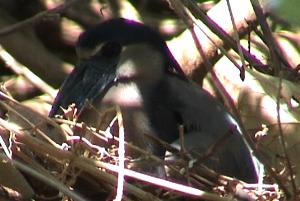
|
| (c) Michael O'Keeffe |
Mar 9th Monteverde cloud Forest Reserve and Finca Ecologica Reserve We arranged a guide at our accommodation however we were not particularly impressed with his ability, having been in the company of some excellent guides during the previous week. We would therefore advise organising a guide in advance if possible. In spite of the inexperience of our guide we connected with most of the birds we needed at the Monteverde Cloud Forest Reserve, including Black-breasted wood-quail, Striped-tailed Hummingbird, Coppery-headed Emerald, Magenta-throated Woodstar, Orange-bellied Trogon, Black-faced Solitaire (common) and Slaty-backed and Orange-billed Nightingale Thrushes. In the afternoon we decided to visit Finca Ecologica Reserve without a guide. Here we found Orange-billed Nightingale thrush and Ovenbird to be common and surprisingly confiding. A Three-wattled Bellbird was heard and other highlights included Emerald Toucanet, White-throated Thrush, Three-striped and Kentucky Warblers and White-eared ground-sparrow (common). The real highlight at Finca was a confiding Chiriqui quail-dove. The area also contains lots of White-nosed Coati and Agouti. This reserve is well worth a visit.
| Monteverde Cloud Forest Reserve |
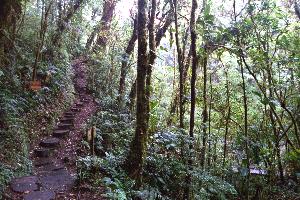
|
| (c) Michael O'Keeffe |
| White-nosed Coati |
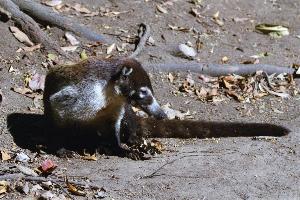
|
| (c) Michael O'Keeffe |
| Chiriqui Quail-dove |
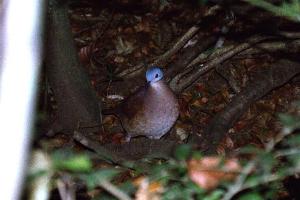
|
| (c) Michael O'Keeffe |
Mar 10th Monteverde and Palo Verde
We spent the morning of March 10th checking forest at various elevations for the Three-wattled Bellbird. While we heard the bird, frustratingly, we failed to get into any areas where they were calling. Eventually we made our way back down towards the pacific coast to the wetland reserve of Palo Verde. The road in to the reserve produced Plain-breasted Ground-dove and Scissors-tailed Flycatchers. Birding proved quite fruitful for wetland birds however we consider that the habitat was too dry for forest birds and so we scored average to poor in that category. Palo Verde is well worth a visit, if only for the spectacle of thousands of Black-bellied and Fulvous whistling ducks. Other birds seen from the road beside the marsh include Limpkin, American Coot, Blue-winged Teal and Shoveler. We climbed the Cactus trail to obtain views over the main lake and it was on this trail that we encountered what was by far the Mammal of the entire trip - a stunning Margay. This medium sized cat had been hunting White-tipped doves. Having caught a dove which had been disturbed by the noise of our advance up the trail, the Margay casually moved away in full view, seemingly undeterred by our presence. Cats are always a bonus on any trip, however it was only after we had reported our sighting, showing Seamus's excellent video footage to the ranger at reception that we became aware of just how rare this sighting was! From the top of the Cactus trail we were able to scope a stunning Jabiru Stork feeding in amongst the Wood Storks. We also had a single Muscovy and a Black-crowned night heron from this vantage point. We spent the night at the OTS Station which was comfortable and affordable. A short night-drive produced lots of Pauraque along with Forest Rabbit and White-tailed Deer. We were told that a Puma had been recently seen by a visitor during night time stake out in the park's camping area.
| Monteverde |
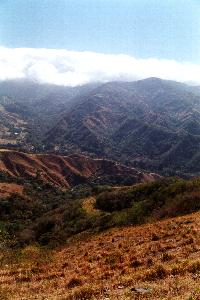
|
| (c) Michael O'Keeffe |
| Margay |
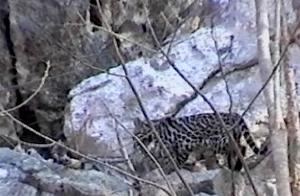
|
| (c) Seamus Enright |
Mar 11th Palo Verde, Arenal and La Selva Biological Station We birded Palo Verde once more in the morning before beginning the long journey north around Laguna de Arenal to La Selva. There was a noticeable absence of forest birds however we did manage to locate Great Currassow and Double-striped Thicknee. The long road trip around Volcano Arenal provided some stunning scenery but few birds of note. We eventually arrived at La Selva Biological Station after dark, just in time for our scheduled night walk. Guided night and dawn walks at La Selva are expensive, at US$38 per person. The night walk was an interesting experience. However, were it not for the fact that we had some cracking views of a calling Great Potoo, it might not have been considered good birding value for money. The frightening calls of this bizarre bird have to be heard to be believed! Nice animal sightings included a Tarantula and a Two-toed Sloth. It is recommended booking accommodation at La Selva well in advance. This can be done over the internet.
| Palo Verde National Park |
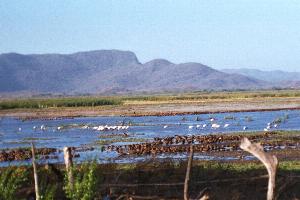
|
| (c) Michael O'Keeffe |
| Ctenoasaur |
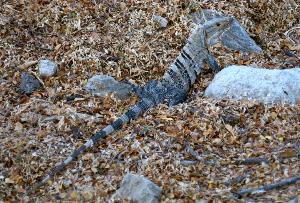
|
| (c) Michael O'Keeffe |
| Palo Verde viewed from the Cactus Trail |
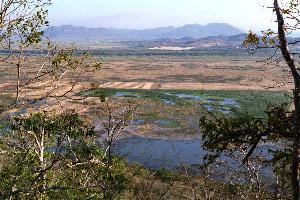
|
| (c) Michael O'Keeffe |
| Laguna de Arenal |
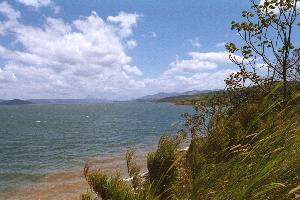
|
| (c) Michael O'Keeffe |
Mar 12th La Selva Biological Station
La Selva is a must for any birding trip to Costa Rica. The station is located off the main road between Puerto Viego de Sarapiqui and Tigre. The road into the reserve (through fairly open countryside) and the gardens prior to the bridge within the reserve itself can both be birded without a guide. It is remarkable just how many species are to be found in these areas. For proper forest birding however one must enter the trails beyond the bridge and this requires a guide. Morning and afternoon guided walks cost US$25 per person. Accommodation on site costs US$65, which helps support the valuable research taking place at the station. We would recommend staying on site and taking the dawn birding walk which begins at 6am (another US$38). Carlos Luis Jiménez (tel: 375-1978 / e-mail: tramonto85@yahoo.com) was our excellent guide on our dawn walk. Birding highlights included Little Tinamou seen well, Bat Falcon and Pied Puffbird. After breakfast we took the standard morning walk which was far less productive from a birding point of view, although we were given a superb insight into the flora and invertebrate life of the reserve. A chance encounter with an Olive-backed quail-dove was at least some reward. We would advise making every effort to avail of the services of a dedicated bird-oriented guide when visiting La Selva on a day trip. Luckily, we met up with Carlos again in the afternoon and were treated to a superb evening's guided walk. The highlights included a stunning Agami Heron, Semiplumbeous Hawk, Sungrebe (magic!), Short-billed and Pale-vented Pigeons (common), Olive-throated Parakeet, Great Potoo (at a day roost), Band-tailed Barbthroat, Red-footed Plumeleteer, Violet-headed and Blue-chested Hummingbirds (near the restaurant), Black-throated Trogon, Chestnut-coloured Woodpecker, Purple-throated Fruitcrow, Black-thraoted Wren (common), Song Wren (an excellent find), Dusky-faced Tanager and Olive-backed Euphonia. We had nice views of a bright yellow Eye-lid Pit-viper beside the trail along with plenty of Strawberry poison arrow frogs. Towards dark we departed La Selva for nearby Selva Verde Lodge where we spent the night.
| Two-toed Sloth |
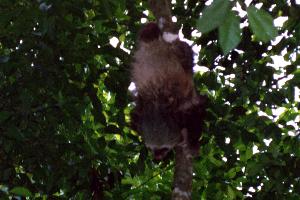
|
| (c) Michael O'Keeffe |
| Red-legged Honeycreeper |
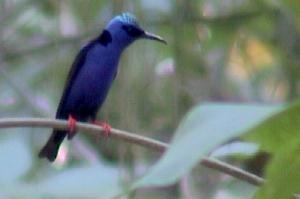
|
| (c) Michael O'Keeffe |
| Sungrebe |
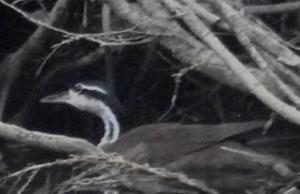
|
| (c) Seamus Enright |
| Agami Heron |
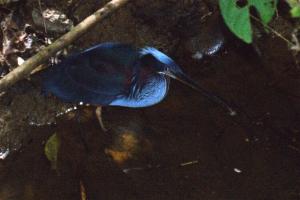
|
| (c) Michael O'Keeffe |
Mar 13th Selva Verde Lodge, La Selva Biological Station
Selva Verde Lodge offers luxurious accommodation and excellent restaurant facilities. There are also birding guides available and a pretty good series of trails. After reading the various trip reports on the web, we had decided to divide our time in this area between La Selva biological station and Selva Verde Lodge. However, in hindsight La Selva provided by far the best birding opportunities. There is one species which is a must at Selva Verde Lodge however and that is Sun Bittern. Luckily the bird is almost guaranteed at the gravel banks and islands along the Sarapiqui river, right beside the lodge. Buff-rumped warblers and a Green and Black species of Poison Arrow Frog appear to be very common at the lodge. If Sun Bittern is the only species you are after, then perhaps it might be better to try and visit the river by arranging a fee at reception. There is plenty of reasonably priced accommodation available in Puerto Viego de Sarapiqui, just five minutes away, for those trying to keep to a strict budget. We found the early morning bird walk at Selva Verde Lodge to be of limited value due to the large numbers of people in attendance. Sun Bittern and Amazon Kingfisher were the highlights. After breakfast we decided to head back to the entrance road to La Selva where we faired much better. Here the highlights included Bronzy Hermit, White-ringed Flycatcher and Grey Catbird. We divided our afternoon's birding between La Selva and Selva Verde Lodge. The highlight was surely a young Boa Constrictor which we stumbled upon as it lay across the trail (mimicking the far more deadly Fer-de-lance)! We spent the night in Puerto Viego de Sarapiqui at the very reasonably priced Mi Lindo Sarapiqui.
| Sun Bittern |
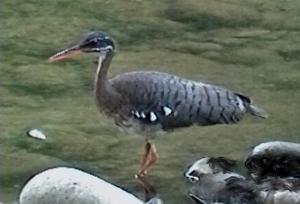
|
| (c) Seamus Enright |
| Boa Constrictor |
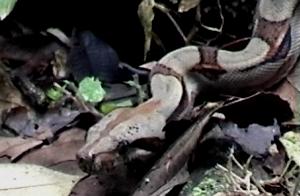
|
| (c) Michael O'Keeffe |
| Savegre lodge - luxury birding |
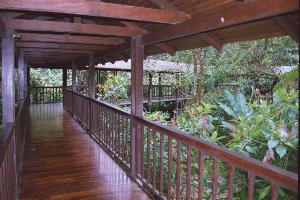
|
| (c) Micael O'Keeffe |
Mar 14th Braulio Carrillo National Park and Grasslands near Puerto Viego There are a number of optional day-trips for those staying in the genera vicinity of Puerto Viego de Sarapiqui. These include La Selva Biological Station, Poas Mountain, Virgen de Socorro and Braulio Carrillo National Park. Poas and Virgen de Socorro offer mid to high elevation forest species. Both sites appeared on most Trip Report Itinerary's on the web. However, as were were doing quite well with mid to high elevation birds, we decided to get back into low to mid elevation rain forest and give these sites a miss. We were fortunate to be able to acquire the guiding services of Carlos Luis Jiménez for a day trip to Braullio Carrillo. This park has a number of excellent trails. In spite of the prolonged showers which are a constant feature of Braulio Carrillo, we managed to pull out some magnificent birds, among them a spectacular Ornate-hawk Eagle (perched less than 75 metres away), Lattice-tailed Trogon, Cinnamon Woodpecker, Southern Nightingale Wren (brief, frustrating views), Pale-vented Thrush, White-vented Euphonia and Tawny-crested Tanager. A Sharpbill was also heard. In the afternoon, Carlos brought us to a grassland site beside the main road, not far from Puerto Viego de Sarapiqui where, in the space of 20 minutes we had bagged Striped Cuckoo, Red-breasted Blackbird, Eastern Meadowlark and Nicaraguan Seed-finch! A superb day! We spent the night once more at Mi Lindo Sarapiqui.
| Lattice-tailed Trogon |
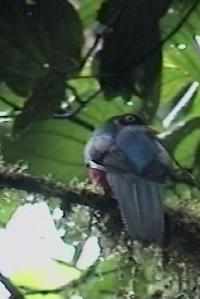
|
| (c) Seamus Enright |
| Red-breasted Blackbird |

|
| (c) Seamus Enright |
Mar 15th La Selva Biological Station and highway south to san Vito We met up with Carlos once more for some final birding along the road into La Selva Biological Station and some sites nearby. As a result, we managed to add the following species to our list: Solitary Sandpiper, Lesser swallow-tailed swift, Rufous-winged Woodpecker, White-winged Beckard, Long-tailed Tyrant, Yellow-tailed Oriole, Plain-coloured Tanager and Slate-coloured Grosbeak. It is remarkable that we left Costa Rica without having seen two species which are common along the road into La Selva Biological Station (Yellow-billed Cacique and Great Antshrike, both heard only). Such is the nature of birding! After bidding farewell to Carlos, we began the VERY long journey along the intercontinental highway, right down to the south of Costa Rica. We reached San Vito many hours after dark where we managed to locate accommodation for the night.
| Agouti |
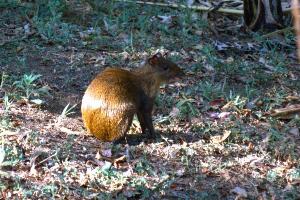
|
| (c) Michael O'Keeffe |
| 'Green and Black' poison arrow frog |
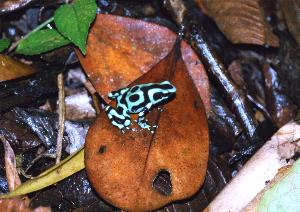
|
| (c) Michael O'Keeffe |
| Basilisk |
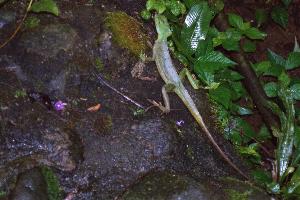
|
| (c) Michael O'Keeffe |
Mar 16th Wilson's Botanical Gardens
In the morning we stopped at the pond near the airstrip as recommended in the site guide (see reference material above). This produced Moorhen and Purple Gallanule. Wilson's Botanical Gardens open at 8.00am however we were able to bird the entrance beforehand. The best birding of the morning was had along Tree Fern Hill where we located the following birds: Blue-crowned Motmot (common), Red-rumped Woodpecker, Spectacled Foliage-gleaner, Streaked flycatcher, Thick-billed Euphonia (common) and Grey-headed and Silver-throated Tanagers (common). At the entrance to the Jungle trail (which, according to the regulations should not be entered without a guide) we located Spotted-crowned Euphonia, Emerald Tanager and Red-crowned Ant-tanager. In the afternoon we visited a pond near San Joaquin, referred to as the Wetlands of San Joaquin in the site guide. Here we found many of the species referred to in the guide, including Masked Duck, Blue-headed Parrot, Eastern Wood-Pewee, Bran-coloured Flycatcher, Streaked Saltator, Masked Yellowthroat and Black-headed Brush-finch (the latter a very nice find). We spent the night once more at San Vito.
| Blue-crowned Motrmot |
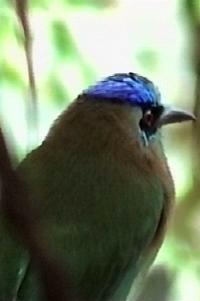
|
| (c) Seamus Enright |
Mar 17th Wilson's Botanical Gardens and Golfito We started birding once more at the pond near the airstrip. Among the Variable Seedeaters and the Blue-black and Yellow-faced Grassquits were two surprise species, White-collared Seedeater and Yellow-bellied Seedeater. A short visit to Wilson's Botanical Gardens yielded an Eye-ring Flatbill. We then made our way towards the Pacific coast and Golfito. The steep road toward the communication mast above Golfito provided a few good birds, most notably a pair of Golden-naped Woodpeckers. As evening descended, we visited the mangroves on the edge of Golfito where we were fortunate with a chance sighting of a Grey-necked Wood-rail. We later drove as far as San Isidro de El General where we stayed for the night.
| Golden-naped Woodpecker |
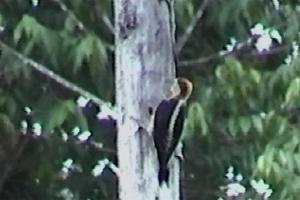
|
| (c) Seamus Enright |
Mar 18th Savegre Lodge to Orotina At this stage of any trip the availability of new birds becomes a limiting factor. Consequently we had consciously left the schedule of the last few days open. We made the decision to concentrate on quality over quantity, setting in our sights the remaining high-elevation endemics. We therefore returned to Savegre Lodge on the morning of March 18th. Luckily, we met Mario, one of the guides, at the entrance to Savegre and he was willing to take us out birding for the day. We were concentrating on five key species, namely Bare-shanked Screech Owl (sadly, no roost sites were available), Buffy Tuftedcheek (we had excellent views), Streaked-breasted Treehunter (heard only), Silvery-fronted Tapaculo (we had excellent views of this skulker), Silvery-throated Jay (very good views of these stunning birds) and Buff-fronted Quail-dove (heard only). I guess, three out of five ain't bad! Before departing, Mario took us to a site for Buff-crowned Wood-partridge. We spent an hour stalking a number of actively calling individuals to no avail - a frustrating end to an otherwise very enjoyable day. Mario and Melvin are both extremely dedicated guides who will go our of their way to track down key species. With time closing in on us, we decided to drive the long journey after dark to spend the night at Orotina, for a final return journey to Carara National Park.
| Volcano Hummingbird |
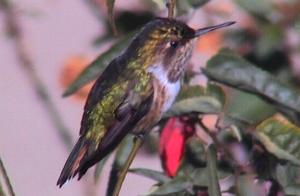
|
| (c) Michael O'Keeffe |
| Spot-crowned Woodcreeper |
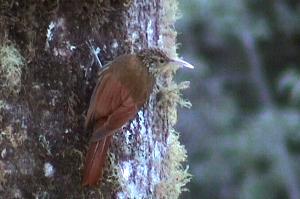
|
| (c) Michael O'Keeffe |
| Silvery-fronted Tapaculo |
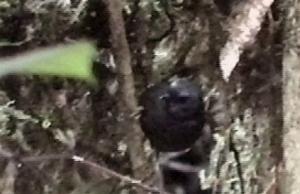
|
| (c) Seamus Enright |
Mar 19th Carara National Park We returned to Carara National Park in the hopes of connecting with one or two of the species missed on the previous visit. A few hours of very enjoyable birding provided new birds in the form of Yellow-naped parrot, Collared forest-falcon and Rufous Piha. In the afternoon we decided to take a well-earned rest from birding with a visit to the beach resort town of Jaco. The late evening was spent driving back up to Monteverde for one last look. We stayed in Santa Elena.
| Black-hooded Antshrike |

|
| (c) Michael O'Keeffe |
| Chestnut-backed Antbird |
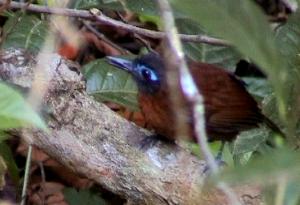
|
| (c) Michael O'Keeffe |
| Orange-collared Manakin |
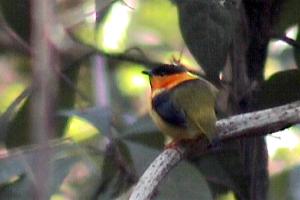
|
| (c) Michael O'Keeffe |
Mar 20th Monteverde
Having failed to get views of Three-wattled Bellbird on our previous visit we made one last effort to locate these distinctive birds. Bellbirds are altitudinal migrants, spending the winter in the lowlands and returning to the highland forests at Monteverde to breed. In mid March, the birds are at mid elevation, gradually making their way up to Monteverde. We tracked down a number of singing birds near San Luis. However, frustratingly, most of them were calling from distant locations where access was proving difficult. Finally, we managed to locate a bird calling less than 100 metres from the road. Coincidently a trail led from the road to the foot of the tree from where the bird was heard calling. Surely, we thought, we had the species in the bag. Sadly it was not to be. The bird stopped calling and disappeared without trace. With the rental car due back in San Jose, our final opportunity was lost.
With every birding trip there are those that got away. However, we were extremely fortunate with the itinerary we chose and for the large part luck was on our side. Of course, countless hours of painstaking preparation also had a lot to do with it! We returned the car at 2.00pm and spent the afternoon shopping near the airport. Mar 21st Return flight to Ireland
| Waterfall, Monteverde Cloudforest Reserve |
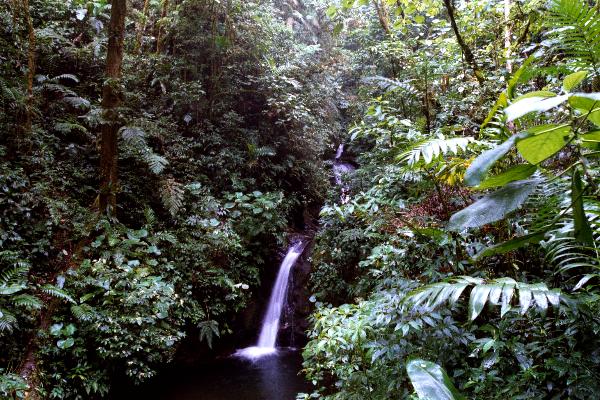
|
| (c) Michael O'Keeffe |
| La Selva Biological Station |
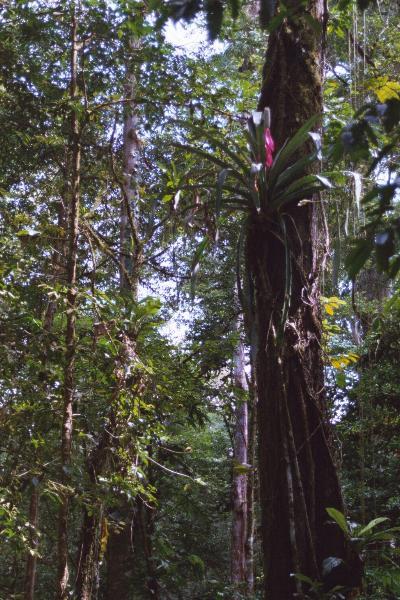
|
| (c) Michael O'Keeffe |
|

